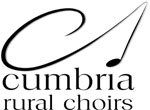2019 concert: Haydn's Seven Last Words; Mozart's Requiem
Carlisle Cathedral was the venue for Cumbria Rural Choirs’ 2019 concert, which featured two of the finest pieces of church music of the end of the 18th century - Haydn’s The Seven Last Words of Christ and Mozart’s Requiem. A large audience enjoyed a well-presented concert in which the choir of over 100 voices was joined by four excellent soloists and the equally impressive British Sinfonietta.

Haydn’s Seven Last Words, written for Cadiz Cathedral in 1787, is a sombre work. Its seven movements, all but one prefaced by a simple choral chant (accompanied by Ian Pattinson on a chamber organ), are outwardly similar in nature and were intended for liturgical use with readings and homilies between each movement. Haydn makes this more approachable in a non-liturgical context by the constant interplay of soloists and chorus, the variety and ingenuity of the orchestral textures and the use of both harmonic and imitative writing for choir; there are some striking and effective dynamics contrasts throughout. From the start there was much evidence of careful preparation as the choir showed a sure sense of phrasing - refined and sensitive, with good control of the contrasting dynamics that each movement offered. By the 1780s the symphony orchestra was becoming established much as today with the recent addition of clarinets and trombones. Here too we had a contra-bassoon added to the texture, particularly effective in the introduction to the 5th movement, entirely written for wind instruments - a dark and remarkable sound. The orchestra was also to the fore in the dramatic opening overture and the concluding “Earthquake”, where, despite the addition of chorus, Haydn’s writing was very much in their favour.

Mozart’s Requiem (1791) offered more familiar territory. Last sung by the Rural Choirs in 1998, this great final work of Mozart was given a performance of authenticity and style. After a serene and spacious opening, the fugal section of the opening chorus was sung with precision and purpose. A thrilling Dies Irae followed and the succeeding quartet, Tuba Mirum, gave the four soloists, Susanna Fairbairn (soprano), Katie Bray (alto), Paul Smy (tenor) and Andrew Slater (bass), the opportunity to show their individual skills - the opening dialogue between bass and trombone was one of the highlights of the evening. Beautifully-phrased quiet singing from sopranos and altos in Confutatis maledictis was matched by the whole choir in Hostias et preces tibi and the passionate, tender Lachrymosa was another real highlight. The Requiem offers challenges to choirs in picking up the exact speed of each movement, but the beginning of Domine Jesu was the only time this was apparent - the changes of time in both the Sanctus and Benedictus were accomplished with ease. The Benedictus also offered some uplifting moments in the majestic dialogue between soloists and wind instruments. The choir was on excellent form, the sound was well-balanced, and the whole performance evidence of the quality and detail of preparation by Ian Wright (chorus-master of Cumbria Rural Choirs) and the directors of the various participating choirs.

John Butt (this year’s guest conductor) clearly had a very strong imprint on the style and authenticity of the performance and deserves much credit for fashioning such a satisfying, and much appreciated, concert, which showed that the English choral tradition is still in good heart.
Colin Marston
